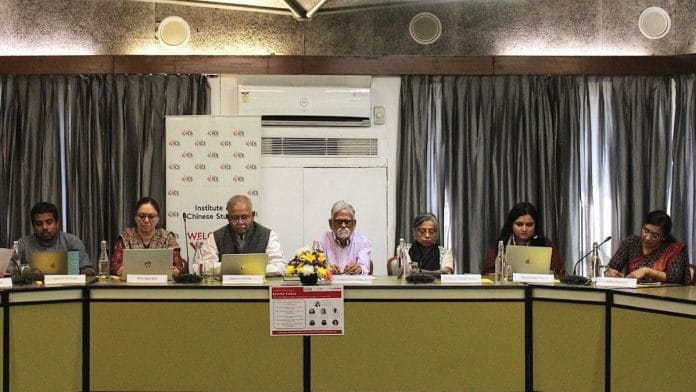New Delhi: The Chinese government is facing the challenge of attempting to grow its way out of its current economic conundrum through exports, which will be hit by the massive tariffs introduced by US Donald Trump last week, former Indian Ambassador to Beijing Ashok K. Kantha has said during a roundtable discussion.
“Essentially, what should be the primary driver of growth in the Chinese economy? Should it be a domestic factor or an external factor?” said Kantha, while speaking at a roundtable organised by the Institute of Chinese Studies Saturday.
“After the first round of Trump tariffs in 2017, 2018, and COVID, and supply chain pressures which came up in May 2020, Politburo decided on the policy of federal circulation, which is essentially that their domestic demand should be boosted, and that will be internal circulation, while maintaining engagement with global markets, which will be external circulation.”
The former Indian ambassador added, “Domestic demand should take primacy. This was formalised in the 14th five-year plan, which was adopted in October 2020. This issue received a lot of attention at the last ‘Two Sessions’ in March. But it has had a somewhat turbulent past because the CPC (Communist Party of China) government has not really been able to handle this problem in a way which will lead to reduced dependence on external segments, especially exports. Private demand has just refused to pick up.”
It remains about 38-39 percent of the GDP as compared to 55-60 percent for other comparable economies, he added.
However, despite its large export surplus of close to $1 trillion last year, its domestic demand remains slow, in a situation reminiscent of Japan in the late 1980s, added Kantha. “You had reliance on export, which could not pull the [Japanese] economy out of there, of nearly three decades of pitiful stagnation. I don’t believe China is in that situation yet. There are many drivers of growth, but it’s a difficult situation,” he said.
Beijing has been unable to increase the private consumption by Chinese citizens while relying on the growth of its economy through its exports, but this has, however, faced a large stumbling block in recent weeks—the Trump tariffs.
Trump, during his first term, set about imposing tariffs on China in particular, which were extended by his successor, Joe Biden. Since returning to the White House, Kantha highlighted how Trump has introduced two tranches of 10 percent tariffs on Chinese imports, along with the 34 percent additional tariffs introduced on 2 April, as a part of his reciprocal tariff policy.
“If you take into account Trump-1 tariff plus Biden tariff, it will be somewhere close to 68 to 76 percent,” said Kantha, highlighting the challenge before Beijing. Trump has also taken issue with China’s ability to reroute their exports via third countries such as Mexico, Vietnam, Thailand and Malaysia and has through his latest tariffs closed this “backdoor”, which adds further challenges to Beijing’s economy.
Kantha was speaking at a roundtable on understanding the ‘issues and themes in China’s National People’s Congress 5-11 March 2025.’
The other speakers at the roundtable included Sreemati Chakrabarti, former professor at the Department of East Asian Studies, University of Delhi, Anand P. Krishnan, fellow, Centre for Himalayan Studies at Shiv Nadar University, Ritu Agarwal, associate professor at Jawaharlal Nehru University, Rityusha Mani Tiwary, Department of Political Science at the University of Delhi, and Usha Chandran, assistant professor at Jawaharlal Nehru University.
The discussion was moderated by Manoranjan Mohanty, the former director at the Developing Countries Research Centre at the University of Delhi.
The speakers covered a number of issues emanating from the conclusion of the ‘Two Sessions’—the annual meetings of the National People’s Congress (NPC) and the Chinese People’s Political Consultative Conference (CPPCC) last month.
This edition of the Two Sessions focused on domestic issues within China, including its rural revitalisation strategy, increasing support for the private sector, and efforts to stimulate domestic consumption and to reduce its reliance on exports.
The speakers delved into each individual theme, with Chakrabarti speaking on the origins of the NPC and its evolution, Kantha focusing on China’s economy—exports versus internal consumption—and Krishnan examining the country’s private sector and its increasing vote of confidence in the party-state.
Agarwal focused on China’s rural revitalisation plans, while Tiwary elucidated on Beijing’s innovation in artificial intelligence (AI), and Chandran highlighted the role of women and reproduction in the Chinese economy.
ThePrint was a media partner at the event.
Also Read: Amid trade war with US, China’s Exim Bank backs relocation of Chinese manufacturing to Bangladesh






